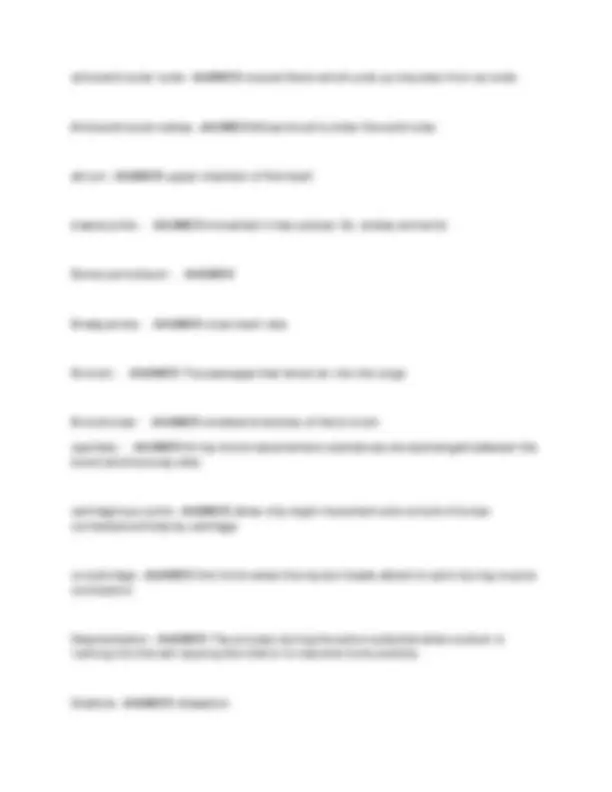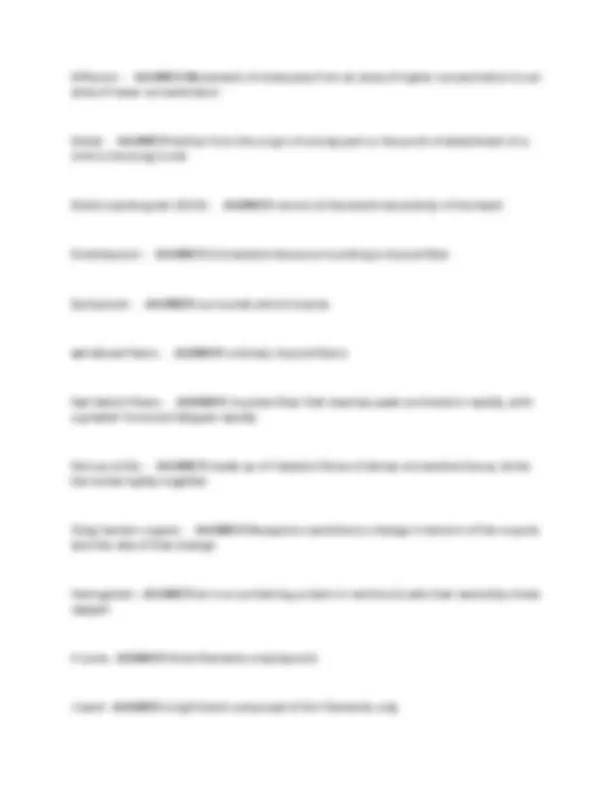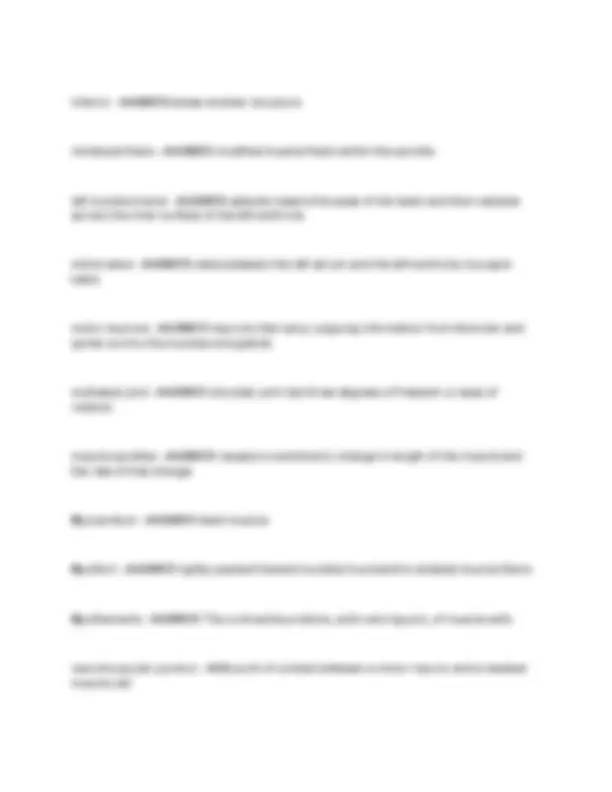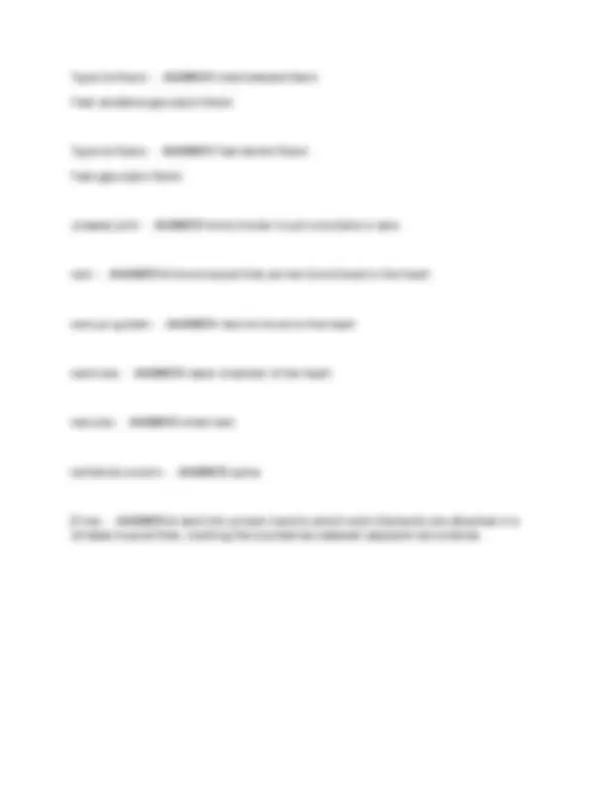







Study with the several resources on Docsity

Earn points by helping other students or get them with a premium plan


Prepare for your exams
Study with the several resources on Docsity

Earn points to download
Earn points by helping other students or get them with a premium plan
Community
Ask the community for help and clear up your study doubts
Discover the best universities in your country according to Docsity users
Free resources
Download our free guides on studying techniques, anxiety management strategies, and thesis advice from Docsity tutors
A comprehensive list of key vocabulary terms related to anatomy and physiology, particularly focusing on the musculoskeletal and cardiovascular systems. Each term is accompanied by a concise definition, making it a valuable resource for students studying these subjects. A wide range of topics, including skeletal structures, muscle types, muscle contraction mechanisms, and the anatomy and function of the heart and lungs.
Typology: Exams
1 / 9

This page cannot be seen from the preview
Don't miss anything!






axial skeleton - ANSWER Includes the skull (cranium), vertebral column (vertebralcolumn (vertebra C1 through the coccyx), ribs and sternum.
appendicular skeleton - ANSWER Bones of the limbs and limb girdles that are attachedto the axial skeleton.
musculoskeletal system - ANSWER muscles, bones, joints and tendons hyaline cartilage - ANS Most abundant type of cartilage; it provides the covering at theends of the bones; nose, ribs and long bones Synovial Fluid - ANS joint lubrication fluid produced by the synovial membrane Tendon- ANS It connects muscle and Bone boneperiostium -ANS a specialized connective tissue overlaying all bone
muscle fibre - ANSWER A muscle cell, especially one of the cylindrical, multinucleatecells that make up skeletal muscles and are composed of numerous myofibrils that contract when stimulated. a-band - ANSWER dark area; extends length of the thick filaments Acetylcholine - ANSWER A neurotransmitter that enables learning and memory and alsotriggers muscle contraction
Actin - ANSWER thin filaments action potential -an axon ANSWER a neural impulse; a brief electrical charge that travels down
Fasciculi - ANSWER bundles of muscle fibers motor unit - ANSWER A motor neuron and all of the muscle fibers it innervates Myofibrils - ANSWER Microscopic protein filaments that make up muscle cells. Myosin - ANSWER thick filament all-or-none principle -occurs either full-blown or not at all. ANSWER Refers to the fact that the action potential in the axon
alveolar pressure - ANSWER pressure within the lungs Alveoli -between air and blood ANSWER tiny sacs of lung tissue specialized for the movement of gases
aortic valve -that prevents blood from flowing back into the left ventricle. ANSWER The semilunar valve separating the aorta from the left ventricle
arterial system - ANSWER carries blood away from the heart Arteriole - ANSWER small artery artery - ANSWER A blood vessel that carries blood away from the heart atrioventricular bundle - ANSWER continuation of the specialised tissue of the AV node,and serves to transmit the electrical impulse from the AV node to the Purkinje fibres of the ventricles.
Diffusion -area of lower concentration. ANSWER Movement of molecules from an area of higher concentration to an
Distal -limb to the body trunk ANSWER farther from the origin of a body part or the point of attachment of a
Electrocardiogram (ECG) - ANSWER record of the electrical activity of the heart Endomysium - ANSWER Connective tissue surrounding a muscle fiber Epimysium - ANSWER surrounds entire muscle extrafusal fibers - ANSWER ordinary muscle fibers fast twitch fibers -a greater force but fatigues rapidly ANSWER muscles fiber that reaches peak contraction rapidly, with
fibrous joints -the bones tightly together ANSWER made up of inelastic fibres of dense connective tissue, binds
Golgi tendon organs -and the rate of that change ANSWER Receptors sensitive to change in tension of the muscle
Hemoglobin - ANSWER an iron-containing protein in red blood cells that reversibly bindsoxygen.
H zone - ANSWER thick filaments only(myosin) I band - ANSWER a light band composed of thin filaments only
Inferior - ANSWER below another structure intrafusal fibers - ANSWER modified muscle fibers within the spindle left bundle branch - ANSWER extends toward the apex of the heart and then radiatesacross the inner surface of the left ventricle
mitral valve - ANSWER valve between the left atrium and the left ventricle; bicuspidvalve
motor neurons - ANSWER neurons that carry outgoing information from the brain andspinal cord to the muscles and glands
multiaxial joint - ANSWER shoulder joint has three degrees of freedom or axes ofrotation
muscle spindles - ANSWER receptors sensitive to change in length of the muscle andthe rate of that change
Myocardium - ANSWER heart muscle Myofibril - ANSWER tightly packed filament bundles found within skeletal muscle fibers Myofilaments - ANSWER The contractile proteins, actin and myosin, of muscle cells neuromuscular junction - ANS point of contact between a motor neuron and a skeletalmuscle cell
potassium into the cell while sodium exits the cell. right bundle branch -across the inner surface of the right ventricle ANSWER extends toward the apex of the heart and then radiates
Sarcolemma - ANSWER muscle cell membrane Sarcomere - ANSWER Contractile unit of muscle Sarcoplasm - ANSWER cytoplasm of a muscle cell sarcoplasmic reticulum - ANSWER Organelle of the muscle fiber that stores calcium. semilunar valves - ANSWER pulmonary and aortic valves located between the rightventricle and the pulmonary artery and between the left ventricle and the aorta
sinoatrial (SA) node - ANSWER A specialized area of cardiac tissue, in the right atrium ofthe heart, where the electrical impulses that initiate a given heart beat are created, often called the natural pacemaker of the heart. sliding filament theory - ANSWER theory that actin filaments move towards each otherwhen muscles contract and thus pull on the myosin filaments; the myosin filaments themselves do not move slow twitch fibers The correct answer is red muscle fibers that are slow to contract butcan continue contracting for long periods of time
Superior The correct answer is Higher on the body, nearer to the head sympathetic nervous system The correct answer is the division of the autonomic
nervous system that arouses the body, mobilizing its energy in stressful situations synovial joints The correct answer is freely movable joints Systole - ANSWER Contraction of the heart Tachycardia - ANSWER fast heart rate Tetanus - ANSWER a sustained muscular contraction resulting from a rapid series ofnerve impulses
Trachea - ANSWER Windpipe. Allows air to pass to and from lungs tricuspid valve - ANSWER valve between the right atrium and the right ventricle Tropomyosin - ANSWER A protein of muscle that forms a complex with troponinregulating the interaction of actin and myosin in muscular contraction
T tubules - ANSWER tubular infoldings of the sarcolemma which penetrate through thecell and emerge on the other side
T wave - ANSWER ventricular repolarization twitch - ANSWER A single quick, jerky muscular contraction from a single nerve impulsefollowed by relaxation.
Type I fibers - ANSWER Slow-twitch fibers Slow-oxidative fibers